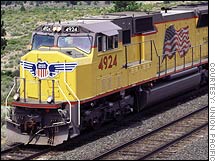U.S. railroad stocks are picking up steamShares of the four major U.S. railroad companies have jumped recently, and all indications are that they'll keep chugging along, says Fortune's Shawn Tully.(Fortune Magazine) -- It is easy to dismiss railroads as smoke-belching relics you'd only want to buy on a Monopoly board. But look again: Since mid-August, shares of the four big U.S. railroads-Burlington Northern Santa Fe (Charts), Union Pacific (Charts), Norfolk Southern and CSX-have been on a tear, picking up almost 25 percent. So why are these companies hot again? Railroads are riding two of the strongest, most durable trends in global business. First, they're ideally suited to carrying the vast volumes of Asian imports that sustain America's retailers and manufacturers.
Second, the run-up in oil and gas prices is making old-fashioned coal a hot commodity again, and railroads are reaping big profits from a staple business, shuttling the black stuff from mines to utilities. Right now a star performer is America's fourth-biggest railroad, Norfolk Southern (Charts). More than any other carrier, it's exploiting "operating leverage," the ability to generate outsized gains in revenues from dollops of new spending. Since 2001, Norfolk Southern's sales have jumped 54 percent, to around $9.5 billion, while its operating expenses grew just 35 percent. Result: an explosion in earnings and a jump in its share price from $18 to $54. To be sure, it's benefiting from the industry's newfound power to raise prices. But it's also the most efficient player, with a knack for moving more and more freight with the same crews and railcars. In 2000, Norfolk Southern shipped 208 carloads per employee. Today the figure is 270. Norfolk's locomotive is its strength in the railroads' fastest-growing business, known as intermodal. Intermodal freight connects ships to trains to trucks in a seamless network: A cargo of clothes, computers or toys from China will arrive in Norfolk by ship. Norfolk Southern then shifts the containers to its flatcars for the hop to Chicago. In the rail-yard the cargo is divided into truckloads and dispatched to warehouses for Wal-Mart and RadioShack. For the long-haul routes, rising gas prices are widening the railroads' edge on costs. Norfolk Southern ships one ton of cargo 410 miles on a gallon of diesel fuel-a pair of locomotives pull more than 200 giant containers in a convoy 17 football fields long-compared with about 120 miles for rival truckers. Norfolk Southern's comeback, deftly recounted in a new book by Rush Loving Jr., "The Men Who Loved Trains," began in the mid- to late 1990s. Until then, Norfolk was a hidebound Southern player that traced its corporate culture to the still-revered Confederate generals who served as its first leaders. But in 1996, Norfolk managed not only to divvy up Conrail with rival CSX (Charts) but to walk away with lines that run alongside rich Pennsylvania coal mines. It also gained a big trunk line in the Northeast-connecting Newark, Philadelphia and Baltimore with Chicago-that made it a power in intermodal. Loving also recounts memorable set pieces: Elizabeth Dole, the Secretary of Transportation, getting so angry at Conrail chairman Stanley Crane that her perfect coif splintered into wild tresses; David LeVan, a Crane successor, arriving by motorcycle at his high-powered lawyer's office in New York City and later upbraiding CSX CEO and future Secretary of the Treasury John Snow for having the gall to want to split up his beloved railroad. And Norfolk's former chairman taking the controls of a giant locomotive himself to fight a strike by engineers. It is a tale of decline and redemption that hits the market just as the sector seems bound for glory. |
|

